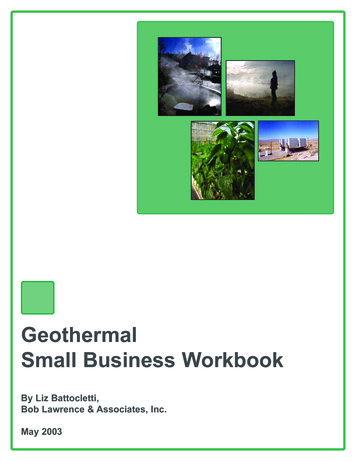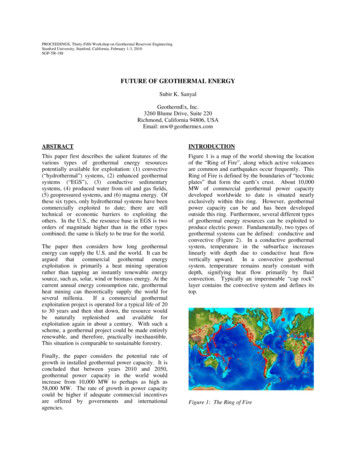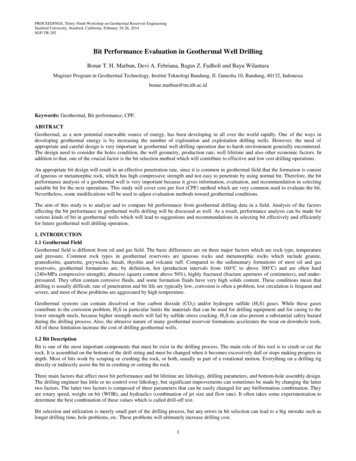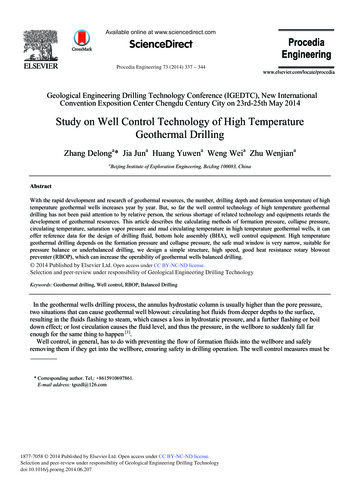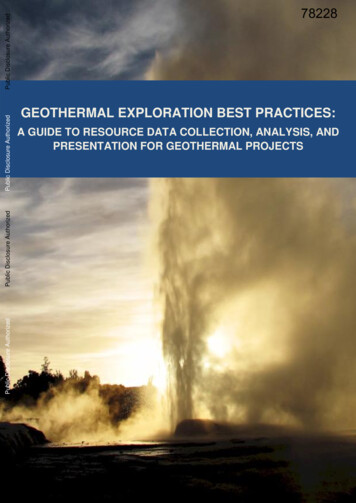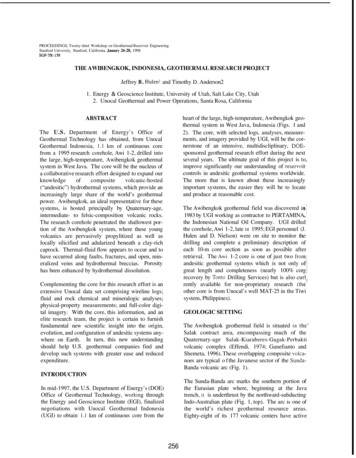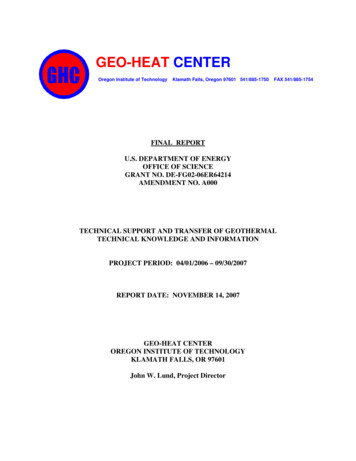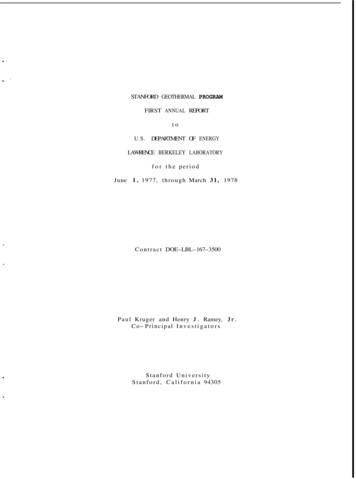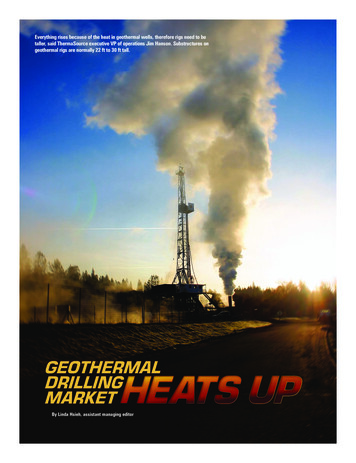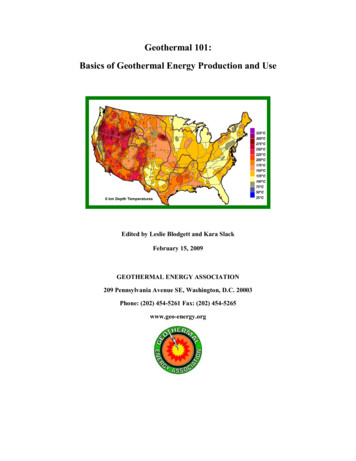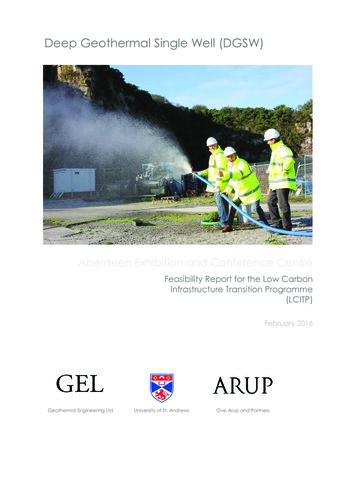
Transcription
Deep Geothermal Single Well (DGSW)Aberdeen Exhibition and Conference CentreFeasibility Report for the Low CarbonInfrastructure Transition Programme(LCITP)February 2016Geothermal Engineering LtdUniversity of St. AndrewsOve Arup and Partners
FOREWORD5SUPPORT – ABERDEEN CITY COUNCIL6EXECUTIVE SUMMARY7RENEWABLE HEAT IN SCOTLAND10DEEP GEOTHERMAL HEAT IN SCOTLAND10REASONS FOR LACK OF DEEP GEOTHERMAL DEVELOPMENT TO DATEHOW THE DGSW ADDRESSES THESE PROBLEMS1013PURPOSE AND SCOPE OF THE STUDY14METHODOLOGY AND PROJECT PARTNERS14GEOLOGY AT THE SITE15GENERAL GEOLOGICAL SETTINGPREVIOUS ENGINEERING GROUND INVESTIGATIONS (AECC PRELIMINARY GROUND INVESTIGATION 2014)ABERDEEN GRANITE COMPOSITION AND EXPECTED GEOLOGY TO 2KMSFORM OF THE ABERDEEN GRANITESTRUCTURAL FEATURESPETROLOGYWHOLE ROCK GEOCHEMISTRYDEEP TEMPERATURE PROFILEGEOCHEMISTRY OF THE SITEGENERAL SETTINGSITE SPECIFIC GEOCHEMISTRY (INCLUDING AT 2KM DEPTH)POTENTIAL FOR SURFACE WATER POLLUTIONRADON GASSUMMARY1516181920212323282828303031REVIEW OF AECC SITE32EXISTING SITE32OUTLINE WELL DESIGN34OPERATIONAL MODESOPERATIONMAINTENANCEINTERFACE WITH ANAEROBIC DIGESTION UNITINTEGRATION AND OPTIMISATION OF DGSW3737383839INSTALLATION METHODOLOGY44DRILLING AND CASING THE WELLDRILLING METHODOLOGY4445
SITE SET UPCELLAR CONSTRUCTIONCONDUCTOR INSTALLATIONRIG MOBILISATIONESTIMATED DRILLING PROCEDURESITE DISMANTLINGHANDLING AND DISPOSAL OF WASTETESTING AND COMMISSIONING4545454545464646REGULATORY REVIEW49SCOTTISH ENVIRONMENT AND PROTECTION AGENCY (SEPA) REQUIREMENTSREQUIREMENTS OF ABERDEEN CITY COUNCILON-SHORE HEALTH AND SAFETY EXECUTIVE (HSE)REVIEW OF CONSENTS AT CREWE PROJECT49505355PUBLIC PERCEPTION AND COMMUNITY ENGAGEMENT56LOW RISK TECHNOLOGYEFFECTIVE COMMUNICATION AND COMMUNITY BENEFITSPUBLIC INTERACTION WITH THE SUB-SURFACEDEEP GEEOTHERMAL EXHIBITION AND COMMUNITY OUTREACHCOMMUNITY ENGAGEMENT PLAN5656575757DRILLING CONTRACTS AND INSURANCE61CONTRACT MODELSTURNKEY CONTRACTDAY RATE CONTRACTSDAY RATE CONTRACT WITHOUT A MAIN CONTRACTOR – MULTIPLE CONTRACTSDAY RATE (WITH MAIN CONTRACTOR) – SINGLE CONTRACTSSUMMARYINSURANCEGENERAL LIABILITYEXPLORATION INSURANCE (WELL PERFORMANCE RISK INSURANCE)CONSTRUCTION ALL RISK INSURANCETECHNICAL RISKSLOST IN HOLE CIAL POTENTIAL AND ROLL OUT71OVERALL MARKET, CONSTRAINTS AND STRATEGYPOLICY DRIVERSCUSTOMER TYPESROUTE TO MARKETOPERATIONS AND LOGISTICS7171737373GEOLOGICAL RISKS
INTELECTUAL PROPERTYCOMPETITIVE ANALYSISFINANCIAL MODELS737374OIL AND GAS INDUSTRY CROSSOVER76EXISTING TECHNICAL & COMMERCIAL RESOURCESENGINEERING AND GEOLOGICAL SKILLSTECHNIQUES, EQUIPMENT & SUPPLY CHAINAECC AS A DEEP GEOTHERMAL DEMONSTRATOR SITE76767677LCA – LIFE CYCLE ASSESSMENT78INTRODUCTIONCONSTRUCTION CARBONOPERATIONAL CARBONOVERALL LCA RESULTS – DGSW VS COUNTERFACTUALSENSITIVITY ANALYSIS AND UNCERTAINTIESLIFECYCLE COSTS787879798182PROJECT DELIVERY AND COSTS84AGREEMENTS CONTRACTS AND PERMITTINGDRILLING AND COMPLETION OF THE WELL, SYSTEM INSTALLATIONTESTING AND COMMISSIONINGINTEGRATIONOPERATION, ANALYSIS AND REPORTING8484858585PROJECT COSTS86OPERATIONAL COSTS – STAFFINGCAPITAL EQUIPMENT AND TRAVELDETAILED DRILLING COSTSRESOURCE MANAGEMENT86899092PROJECT PROGRAMME93PROJECT RISKS96CONCLUSIONS AND NEXT STEPS100REFERENCES101
FOREWORDProfessor Iain StewartProfessor of Geoscience CommunicationPlymouth UniversityScotland’s push for clean, renewable energy means that it is exploring innovative ways to supply heat andpower to communities. The exploitation of geothermal energy is one exciting frontier in how our mixedenergy future might look. This study proposes a highly innovative approach to utilising our undergroundgeothermal resource by advocating the drilling of a deep geothermal single well for the provision ofdecarbonised heat supply to the Anaerobic Digestion Plant and also to local dwellings at the proposedAberdeen Exhibition and Conference Centre.It is considered that this unique ‘two-for-one’ demonstrator opportunity at the Aberdeen conference centrewill be the perfect opportunity to showcase deep geothermal to the local oil and gas industry (highlightingcrossover and supply chain opportunities) and also to educate the public, school children and Universityresearchers on the potential for deep subsurface projects. In that context, it is considered to be the best sitein Scotland for the development of a ‘deep geothermal exhibition’ aimed at improving the public’s ‘visibility’ ofthe subsurface. Equally, if we are to make deep geothermal happen in Scotland, and across the UK, we needto attract potential investors, and I consider that the low-risk, low-cost DGSW provides that commercialinvestment platform and opportunity. In summary, this is a great chance to move decarbonised heat supplyfrom the Earth from academic speculation to commercial reality.5
SUPPORT – ABERDEEN CITY COUNCIL6
EXECUTIVE SUMMARYThis study examines the technical, logistical, contractual and economic feasibility of installing a DeepGeothermal Single Well (DGSW) system at the new site of the Aberdeen Exhibition and Conference Centre(AECC). The site offers a unique opportunity for installing a DGSW as it can be used in four ways:1.2.3.4.To supply low carbon heat to a commercial development (AECC)To supply low carbon heat to nearby residential units using an innovative low temperature heatnetworkAct as a catalyst for deep geothermal energy in Scotland by using the AECC as a showcase project aswell as an educational tool for increasing public awareness of the sub-surfaceDevelop cross-over skills with the established oil and gas industry Heat input to AnaerobicDigestor at the AECCCommercialCommunity Low temperature heatnetwork to nearbyresidential unitsDGSWEducation Showcase project Educational centre on thesub-surface Crossover with oil and gasindustrySkillsThe DGSW has been developed by Geothermal Engineering Ltd (GEL) to overcome some of the barriers thathave hindered the deep geothermal industry in the United Kingdom. The system has been designed to reducethe geological risk, the project delivery time and the cost of delivering deep geothermal heat to buildings.Further, the system does not require ‘fracking’ or hydraulic stimulation in any form. It is therefore more likelyto be acceptable to the public than geothermal projects that involve some form of ‘stimulation’ techniques.This has recently been demonstrated at an urban site near Crewe where a DGSW project achieved thenecessary planning permission and permitting to drill within 3 months and received unanimous public support.The DSGW consists of a 2km vertical well that is drilled and cased with standard oil and gas equipment. Asmall submersible pump and an insulated central pipe extending to the base of the well are installed in the7
centre of the well. Hot water is drawn up through the pipe from the bottom of the well and the heat extractedfrom the water via a heat exchanger for distribution in the building. The cooler water is then rejected back tothe top of the well and descends to the bottom of the well via gravity, heating up on the way before beingcirculated again. The system has been successfully proven in a field trial in 2014 (funded by the Department ofEnergy and Climate Change) and delivered 40kW of heat for every 1kW of electricity used in the pump, i.e. an“efficiency” of 4000%. Peak heat outputs from each DGSW are between 400 and 600kW or enough to supplyheating to around 200 homes. It is a simple system that, once installed, has no visual impact and can be sitednear to the buildings or plant that require heating.Unlike other types of deep geothermal systems, the DGSW is not overly constrained by the underlying geologyand does not rely on the presence of a high permeability, high enthalpy resource. The lack of geologicalconstraint means that the DGSW could be replicated across Scotland. It therefore offers the most realisticmethod of kick starting the commercial development of a deep geothermal heat sector in Scotland andbeyond.In Scotland, the deep geothermal resource at a depth of between 2 and 3km is sufficient to provide more thanenough heat than is realistically possible to deploy in the next 20 years. We therefore believe that limitationsto the deployment of deep geothermal heat systems will not be resource constrained but by logistics such assufficient heat demands at the surface, presence of a network, procurement constraints (buildings in publicownership), drilling rig access, finance and public acceptance.As the DSGW is vertical, there are no third party ownership issues caused by drilling under other landowners(i.e. no requirements for directional drilling). This is very important in the United Kingdom, as there is nolegislation regarding heat ownership and therefore no geothermal licensing framework.As a demonstration site for the technology, the new AECC development is an exciting location. The site hassignificant space for drilling, good road access, a good heat demand match and can serve as an internationalshowcase for the technology (and other renewable energy sources) for visitors to the new exhibition andconference centre. As part of the innovative use of renewable sources at the site, it is proposed that theDGSW provides the base heat requirement for the on site anaerobic digester. This would remove the need foran on-site CHP unit and the need to import gas. The return heat flow from the digester will then be used toprovide heat for a number of nearby residential dwellings using a low temperature heat network. Therefore,with one demonstrator unit, two sustainable heating uses (commercial and domestic) can be demonstratedsimultaneously. We also suggest in this report that the new AECC site could offer the potential of being aninteractive ‘Deep Geothermal Energy Exhibition’ to improve public perception and understanding of thesubsurface but also provide a major outreach opportunity for school children to become interested ingeoscience and sustainable geo-energy.The proximity of the new AECC to Aberdeen also means that there is the opportunity to develop a technicaland commercial skills crossover with the established oil and gas industry. This report argues that, due to theexisting oil and gas skills in Aberdeen, Scotland is in a unique position to be the first mover in the UK in thedevelopment of a deep geothermal energy industry and to roll out a commercial and technical deepgeothermal supply chain.We have explored the permitting that would be required for the DGSW at the new AECC site with both theScottish Environment Protection Agency and Aberdeen City Council and have shared the documentation thatwe developed for a recent DGSW project at Crewe as guidance. We have also included a section on contractsand insurance, as we believe that these will be important aspects of delivering a successful deep geothermalproject on time and on budget.8
A financial model and a Lifetime Carbon Assessment (LCA) have also been completed. The LCA shows that,over the lifetime of the plant, the CO2 savings compared to a conventional gas boiler are 22,170 tCO2e. It isconsidered that, due to the very high overall efficiency of the system, the commercial roll out of the DGSWcould make a significant contribution to aim of decarbonising Scotland’s heat supply.The capital costs for the project are well understood due to recent experience of a similar development inEngland. Further, they can be well constrained due to the structure of the drilling contracts that would beused on the project. The total cost of delivering the demonstration project at the AECC will be 2.3m.The commercial appeal of the DGSW is aided by the fact that the system can typically be installed in under 24months (including planning and permitting). This is significantly shorter than traditional deep geothermalsystems. The cost data for the DGSW highlight that compared to traditional deep geothermal systems (whichwould require directional drilling and more than one well) that it is the lowest cost option available.The next stage in the development of the project will be to move forward with the permitting and drilling ofthe well at the site. This would represent a major step forward in the development of deep geothermal heatresources in Scotland and, due to the high profile of the new AECC, attract significant public interest.Drilling and developing a DGSW at the AECC site will offer a number of benefits: Demonstrate that deep geothermal heat can be provided at low risk in ScotlandProvide a high profile showcase site for deep geothermal heat supply to commercial and domesticusersOffer the opportunity for the creation of a deep geothermal exhibition and education centre.Benefit the immediate local community via return flow heating to dwellingsProvide much needed temperature and geological data from deep on-shore drillingDevelop a system that does not require fracking or “stimulation”. This will be important for ensuringthat the local community are on sideThe commercial opportunity for the DGSW and deep geothermal energy in general can be showcasedto the widest possible audienceThe location can help to establish cross over and supply chain links between the deep geothermalindustry and the oil and gas industry in Aberdeen9
RENEWABLE HEAT IN SCOTLANDIn 2015, the Scottish Government released the ‘Heat Policy Statement Towards Decarbonising Heat:1Maximising the Opportunities for Scotland’ . This statement identifies that the supply of heat accounts for 55%of energy use in Scotland and is responsible for the largest source of carbon dioxide emissions (47%).The statement identifies that the key challenges facing Scotland are as follows: To decarbonise the heat system by 2050 to reduce greenhouse gas emissionsTo diversify sources of heat generation and supply to reduce reliance on fossil fuels and thereforesupport a resilient heat supplyTo reduce energy bills through reducing heat demand and providing affordable heatTo seize the opportunities that this transformation offers through the development of new heatgeneration, distribution and demand reduction programmesWith the aim of helping to take on the key challenges, the Low Carbon infrastructure Transition Programme(LCITP) was launched in March 2015. In consultation with the Geothermal Energy Expert Group the LCITPstarted the Deep Geothermal Energy Challenge Fund from which this study was allocated a grant. The ScottishGovernment has stated that they ”would like to see a self-sustaining geothermal energy sector play asignificant role in our energy future”. The section below discusses the current situation of deep geothermalenergy in Scotland, the limited progress to date and how the deep geothermal single well (DGSW) can providea solution to the development of a commercially viable deep geothermal heat sector in Scotland.DEEP GEOTHERMAL HEAT IN SCOTLAND2As reported by Aecom in their study on the potential for deep geothermal energy in Scotland (August 2013),‘in Scotland there is little direct evidence at the surface of the vast reservoir of stored heat below andgeothermal energy has remained largely untapped’.The report split the geothermal heat resource beneath Scotland into three main settings: abandoned mine workings (low temperature);hot sedimentary aquifers (low and possibly relatively high temperature); andhot dry rocks / petrothermal sources (relatively high temperature).The technology to be discussed in this report (the Deep Geothermal Single Well) aims to deliver heat from twoof these resources across Scotland: hot sedimentary aquifers and hot dry/ wet rocks.REASONS FOR LACK OF DEEP GEOTHERMAL DEVELOPMENT TO DATEThere are a number of well documented reasons why development of deep geothermal projects in Scotlandhas remained ‘largely untapped’. One of the principal problems is the high risk/ low financial rewardassociated with deep geothermal heat supply coupled to high up front capital expenditure on drilling. Thesebarriers are not necessarily unique to Scotland but are compounded by the lack of knowledge of deep onshore temperatures and an established geothermal industry. Figure 1 shows the typical risk/ expenditureprofile of a typical geothermal project and highlights the difficulties project developers face when they reach12Towards Decarbonising Heat. Maximising the Opportunities for Scotland.AECOM Investigating Deep Geothermal Potential of Scotland. 2013.10
the stage of raising funding for drilling. This usually results in projects stalling (stall point, Figure 1) prior todrilling a well. This is strongly supported by evidence from the United Kingdom over the past decade of deepgeothermal development where a number of projects have been planned but not drilled.Project ‘Stall Point’Figure 1: Graphical representation of a typical geothermal project showing risk/ up front capital expenditure (WorldBank, 2013)Compared to other countries within Europe, deep geothermal development in Scotland has been particularlyslow, partly due to the relatively low cost of gas throughout the UK from the North Sea. For the geothermalindustry (heat and power) to develop in Scotland we believe that the following hurdles will need to besurmounted:1.Exploration riskIt is common practice to develop deep geothermal heat systems as ‘doublet’ systems that consist of twowells (one for abstraction and one for re-injection) drilled into a rock that has sufficient permeability todeliver high geothermal fluid flow rates. However, the permeability of the rock (the ability of rock to letwater pass through it) and thus the heat or power delivery of the project is not confirmed until at leastone or often both of the wells has been drilled. This means that every project has a high degree of‘exploration risk’ whilst at the same time requiring significant capital investment (Figure 1). This isparticularly true in countries like Scotland where very few wells have been drilled on-shore to any depth.As the economic returns of a deep geothermal heat project are low, this early stage exploration risk willbe a major hurdle to investment.The only deep geothermal well drilled in the United Kingdom over the last decade is a good example ofexploration risk and demonstrates that the permeability of the rock is not confirmed until the well hasbeen drilled. The Newcastle Science Central Borehole was drilled in 2011 under the lead of Professor Paul11
Younger (then of Newcastle University) with the aim of providing deep geothermal heat to the newbuildings in the Science Central development. The drilling was grant funded, partly from the Departmentof Energy and Climate Change. The aim of the project was to target a highly permeable faulted zone inthe rock at the target depth of close to 2km. Although the eventual well showed that a good geothermalgradient existed (39C km-1), the measured permeability was two magnitudes smaller than predicted. Thismeant that the well could not produce anywhere near the required flow rate and the project stopped.This situation exemplifies the risks associated with relying upon the presence of a high permeabilityaquifer at depth. It also shows that, even if the first well of a doublet system has high permeability, thesecond well may display very different properties. We do not think that this process should be repeatedin Scotland.2.High capital cost per project and delivery timesWithout subsidies or other government incentives such as risk insurance, the economics of deepgeothermal heat delivery are always marginal. This is mainly due to the high cost of drilling a minimum oftwo directional wells per project (one for abstraction, one for re-injection). This is particularly true in theUK, where relatively deep wells need to be drilled to reach suitable temperatures for district heating. Upto 80% of the capital cost of a project is associated with the drilling phase and the funding must beallocated to the project a number of years before the heat plant is constructed and the heat delivered.We believe that the delivery time and the capital cost needs to be significantly reduced before privateinvestment will be forthcoming in Scotland.3.Geographical reachTwo well or doublet systems always have to be located above a geothermal reservoir (geologicalenvironments where sufficient water and permeability is located underground). Either that, or thereservoir needs to be ‘manufactured’ by hydraulic stimulation or sheering. Locations where theseconditions occur are geographically limited and do not often coincide with the location of a heat load. Thegeographical reach of doublet systems is therefore limited and unlikely to be able to meet a meaningfulproportion of the heat demands across Scotland without significant hydraulic stimulation.4.Induced seismicityThe drilling of a deep two well system within low permeability bedrock such as granites and indeed somesedimentary formations would require hydraulic stimulation or ‘fracking’ in order to create a permeabilitypathway for geothermal fluid flow. Normally the deeper the rock, the more difficult it is for water tomove through it. A deep geothermal two well system needs to re-inject cooled water back into the rock atrelatively high flow rates and under high pressure. Injecting fluids into the ground at depth underpressure has been historically associated with induced seismicity as was recently seen at the Preese Hall3shale gas site near Blackpool. It is our belief that the potential for induced seismicity will limit thegeographical locations where doublet systems can be installed (i.e. not in urban areas) and may causesignificant concern within the local community wherever they are proposed. This aspect of deepgeothermal development has not yet been tested in the UK due to the lack of delivery of deep geothermaldoublet projects. However, a community backlash to induced seismicity (however small) could severelylimit the integration of such systems with urban heat demands.3Preese Hall Shale Gas Fracturing, Green, Styles and Baptie, April 201212
5.Heat demandTwo well systems require multiple megawatts of heat demand to be in place above a location that issuitable for drilling. It is our experience that large-scale heat demands and the associated networks provedifficult and time consuming to develop and are rarely above deep geothermal aquifers. In the short termfor Scotland, we think it will be easier to start with smaller scale heat demands (often single owner) sothat the network can be planned and managed to suit the geothermal heat supply.HOW THE DGSW ADDRESSES THESE PROBLEMSOver the past three years, Geothermal Engineering Ltd has been working on the design of a deep geothermalsystem to address these problems and kick-start the delivery of commercially viable geothermal heat in theUK. The resulting Deep Geothermal Single Well (DGSW) system has now been extensively modelled and fieldtrialled in an existing deep well as part of a previous project (2014) funded by the Department of Energy andClimate Change (DECC). The system addresses each of the hurdles listed above in the following ways:1.Exploration riskThe DGSW technology is not dependent on abstracting large quantities of water from the sub-surface(such as the Newcastle Well). Instead, the majority of the water is re-circulated within the well. Thismeans that a successful project does not rely on identifying, targeting and hitting a highly permeable rockat a specific depth. The only requirement is that the temperature at depth is within the operational rangefor the building or plant. This significantly reduces the exploration risk associated with a project, as thetemperature at depth is much better understood than the permeability, which can vary by orders ofmagnitude between different wells.2.High capital cost per project and delivery timesDrilling narrow diameter single vertical wells substantially reduces the upfront capital expenditure of adeep geothermal heat project. The total capital cost of a commercial DGSW system will be between 1.5m and 2.5m, compared to greater than 14m for a directionally drilled doublet system ( 7m perwell) that requires directionally drilled wells. Further, as the DGSW only consists of one vertical well andno plant at the surface, the project delivery time can be reduced to between 12 and 24 months. Thecombination of low risk, short delivery times and reduced capital expenditure means that differentfunding routes can be pursued for these sorts of projects, such as community Crowdfunding. The simplevertical well design also enables turnkey contracts to be developed that reduce the risk of cost over-runsto the developer.3.Geographical reachBecause the DGSW system is not dependent on geothermal reservoirs, that are geographically restrictedin the UK, it has a much greater geographic reach than traditional systems and can be deployed in almostany geological environment where there is a heat demand at the surface. This is important, as heatdemands are often not located above ideal geothermal conditions. The small footprint also means that itis well suited to urban areas and therefore has a more realistic chance of supplying heat to existing endusers than larger scale systems.4.Induced seismicityThe DGSW system does not need to inject fluid into the ground at high pressure and does not need tocreate a reservoir at depth, which is always required in projects utilising doublet systems. In a hard rocksuch as a granite, some degree of stimulation or ‘fracking’ will always be required to engineer a reservoirbetween two wells. There is therefore no risk of induced seismicity when a DGSW is installed and no riskof community backlash. This is very important when trying to develop a new commercial industry. The13
recent induced seismicity at a shale gas site in England caused a two year delay to the entire industrywhilst the Government investigated the incident.5.Heat demandThe heat output of the DGSW is suited to sites where small heat networks can be developed quickly or arealready in place (such as Universities, schools, sports centres, multiple apartment blocks etc). Larger scalenetworks with multiple end users are not required. This enables projects to be developed much faster asthe number of parties involved in the Heat Purchase Agreement and network operation/ management/liability is normally one. Given the relatively small number of large-scale heat networks in place inScotland, the DGSW can be rolled out to many areas that do not have such networks and will, realistically,never have them developed. This is particularly relevant to rural zones that have never even beenconnected to gas grid networks.PURPOSE AND SCOPE OF THE STUDYThe scope of this study is to provide a techno-economic assessment for the installation of a Deep GeothermalSingle Well (DGSW) at the new Aberdeen Exhibition and Conference Centre. The installation of the DGSW willprovide deep geothermal heat from a 2km well drilled into either hot dry rock or hot wet rock (depending onthe geology encountered when the well is drilled to target depth). The study encompasses a geological andgeochemical assessment of the site in conjunction with Arup and St. Andrews University and evaluates theeconomics, permitting, logistics and contractual issues related to the proposed installation. Like all deepgeothermal projects in Scotland, the geology will not be known at depth until the well is actually drilled. Theprimary aim of this report is to provide the detail to support the economic case for funding the next stage ofthe project: permitting, drilling the well and installing the system.METHODOLOGY AND PROJECT PARTNERSGeothermal Engineering Ltd (GEL) has led the project with support from project partners Arup and St. AndrewsUniversity. GEL has previous project experience (2014) of installing and testing the DGSW equipment in anexisting 2.6km well in igneous granite in Cornwall as well as developing geothermal projects around the world.The company is also in the process of obtaining permitting and agreeing contracts for a 2km DGSW system atthe Crewe Campus of Manchester Metropolitan University supported by Arup (a project part funded by theDepartment of Energy and Climate Change). The team therefore has a very good understanding of thepracticalities, contracts, permitting, logistics and costs of progressing with this type of project. For this report,GEL has focused on describing the technology, the expected permitting requirements, installation andintegration issues, contracts and the financial aspects of the DGSW. St Andrews has substantial knowledge ofthe granitic rocks in Scotland and is the logical choice for evaluating the rock type, geochemistry andtemperature that are most likely to be found at the target depths. Arup have provided input into thegeological setting at the site and have provided support in all areas of the project, in particular on planning,public perception, oil and gas synergies and building integration methodologies.14
GEOLOGY AT THE SITEGENERAL GEOLOGICAL SETTINGA review of the available drift and solid British Geological Survey (BGS) geological maps has been undertaken.45The site falls within drift geology map NJ81/91 (1:25,000) and solid geology map and NJ81SE (1:10,560) .SUPERFICIAL GEOLOGICAL MAP1The superficial geology map indicates the site to be predominantly underlain by till described as:“Mainly yellowish brown sandy diamicton with clasts of Dalradian metamorphic and Caledonian igneous rocks,derived locally or from a short distance to the west, Matrix weather in part and containing much decomposed(grussified) rock.”Some areas in the central and southern part of the site are shown to be underlain by alluvium described as:Gravel and sand, capped by silty and clayey floodplain deposits. Based on the fact that the location of theseareas is in close alignment with the existing water courses on the site it is thought that the indicated allu
geothermal resource by advocating the drilling of a deep geothermal single well for the provision of . the project delivery time and the cost of delivering deep geothermal heat to buildings. Further, the system does not require 'fracking' or hydraulic stimulation in any form. It is therefore more likely
